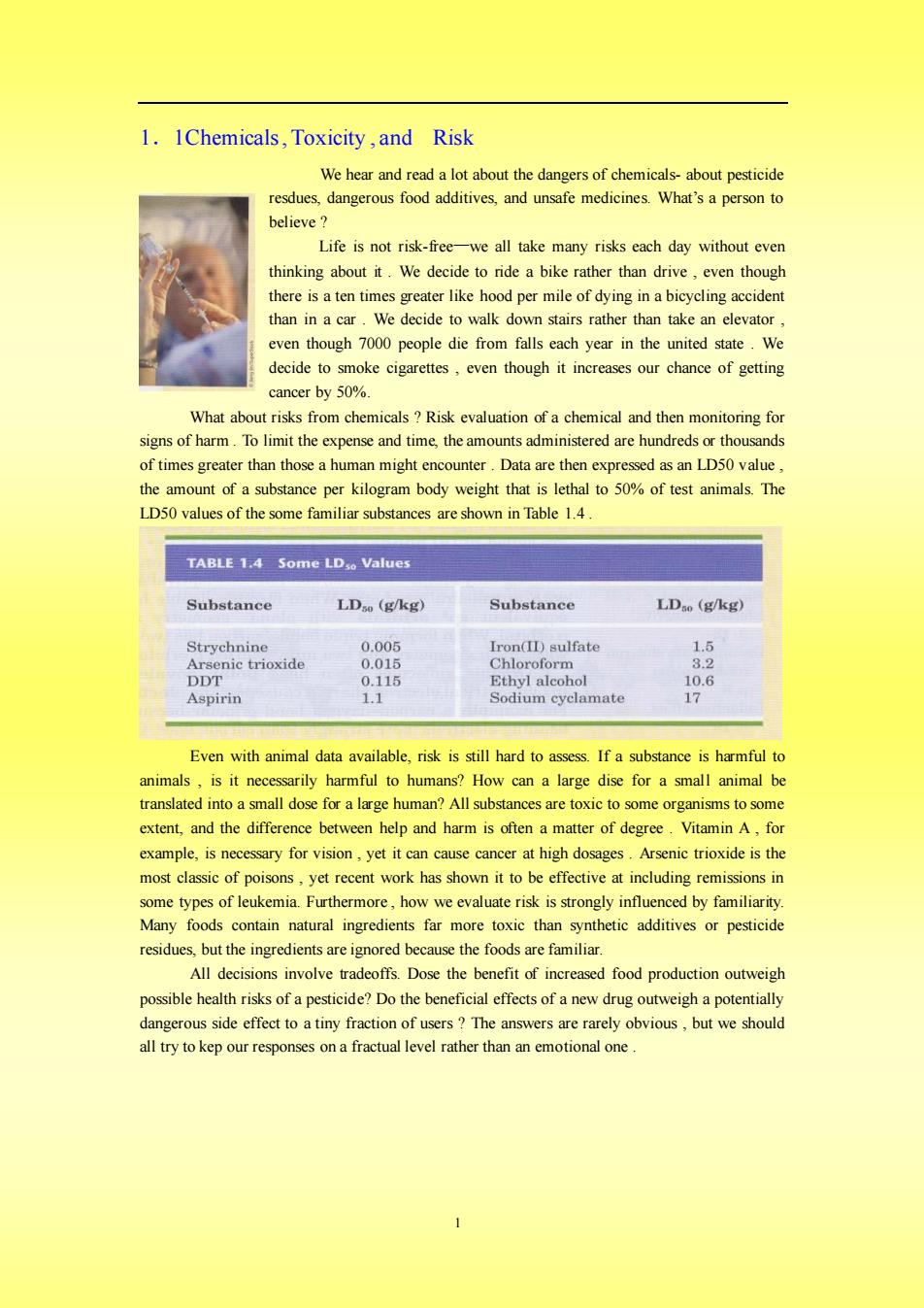
1Chemicals, Toxicity,andRistWe hear and read a lot about the dangers of chemicals-about pesticideresdues, dangerousfood additives, and unsafemedicinsWhat'sa persontbelieveLife is not risk-free-we all take many risks each day without evethinkingride a bikerULthere is a ten times greater like hood per mile of dying in a bicycling accidentthan in a carWe decide to walk down stairs rather than take an elevatoreven though 7000 people die from falls each year in the united state. Wedecide to smoke cigarettes, even though it increases our chance of gettingby.50What abouals?Risk evaluaation ofachemicalandmonitoringfosigns of harmTo limit the expense and time, the amounts administered are hundreds or thousandsoftmesgreaterthanthoseahumanmightencounterDataarethenexpressedasanDaluthe amount of a substance perkilogram body weight that is lethal to50%oftest animals.TheLD50values are shown in Table 1.4ofthesomefamiliarsubstancesTABLE1.4 SomeLDSubstanceLDo (g/kg)SubstanceLDao (g/kg)0.005StrychninIron() sulfate590Dpsenictroxide0.115Sodium eyclamateAspirinIf a substance is harmful toEven with animal data available, riskis still hard to assesharmful tohumans?Hoyanimalm2Alsextent, and the drmisoftedeereexample,isnesaryvinianaueanahghdgsncroxdithmost classic of poisonrecent work has shown it to be effective at including remissions inme types of leukemia.Furthermore,how we evaaluate risk is strongly influenced by familiaritAonscodionoththetic additivespesticidredbecausethe foods are familialns involvetradeoffs.Dose the benefit of increased food production outweiglpossiblehealthrisksofapesticide?Dothebeneficialeffectsofanewdrugoutweighapotentiallydangerous side effectto a tiny fraction of users?The anare rarely obvious, but we shouldall trytokesona fractual level rather than an emtionalo
1 1.1Chemicals , Toxicity , and Risk We hear and read a lot about the dangers of chemicals- about pesticide resdues, dangerous food additives, and unsafe medicines. What’s a person to believe ? Life is not risk-free—we all take many risks each day without even thinking about it . We decide to ride a bike rather than drive , even though there is a ten times greater like hood per mile of dying in a bicycling accident than in a car . We decide to walk down stairs rather than take an elevator , even though 7000 people die from falls each year in the united state . We decide to smoke cigarettes , even though it increases our chance of getting cancer by 50%. What about risks from chemicals ? Risk evaluation of a chemical and then monitoring for signs of harm . To limit the expense and time, the amounts administered are hundreds or thousands of times greater than those a human might encounter . Data are then expressed as an LD50 value , the amount of a substance per kilogram body weight that is lethal to 50% of test animals. The LD50 values of the some familiar substances are shown in Table 1.4 . Even with animal data available, risk is still hard to assess. If a substance is harmful to animals , is it necessarily harmful to humans? How can a large dise for a small animal be translated into a small dose for a large human? All substances are toxic to some organisms to some extent, and the difference between help and harm is often a matter of degree . Vitamin A , for example, is necessary for vision , yet it can cause cancer at high dosages . Arsenic trioxide is the most classic of poisons , yet recent work has shown it to be effective at including remissions in some types of leukemia. Furthermore , how we evaluate risk is strongly influenced by familiarity. Many foods contain natural ingredients far more toxic than synthetic additives or pesticide residues, but the ingredients are ignored because the foods are familiar. All decisions involve tradeoffs. Dose the benefit of increased food production outweigh possible health risks of a pesticide? Do the beneficial effects of a new drug outweigh a potentially dangerous side effect to a tiny fraction of users ? The answers are rarely obvious , but we should all try to kep our responses on a fractual level rather than an emotional one
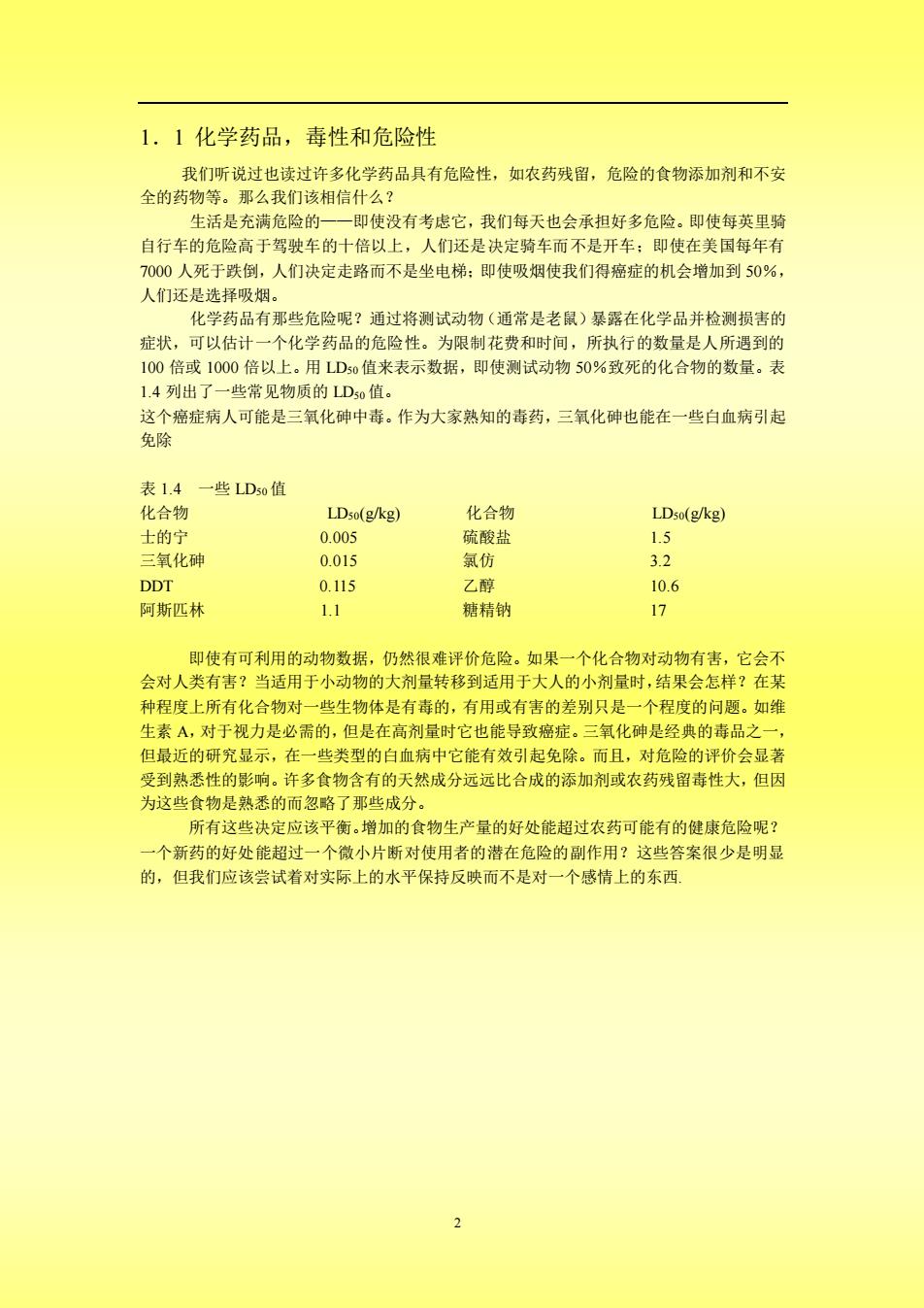
1.1化学药品,毒性和危险性我们听说过也读过许多化学药品具有危险性,如农药残留,危险的食物添加剂和不安全的药物等。那么我们该相信什么?生活是充满危险的一——即使没有考虑它,我们每天也会承担好多危险。即使每英里骑自行车的危险高于驾驶车的十倍以上,人们还是决定骑车而不是开车;即使在美国每年有7000人死于跌倒,人们决定走路而不是坐电梯;即使吸烟使我们得癌症的机会增加到50%,人们还是选择吸烟。化学药品有那些危险呢?通过将测试动物(通常是老鼠)暴露在化学品并检测损害的症状,可以估计一个化学药品的危险性。为限制花费和时间,所执行的数量是人所遇到的100倍或100倍以上。用LD50 值来表示数据,即使测试动物 50%致死的化合物的数量。表4列出了常见物质的LDso值。这个癌症病人可能是三氧化砷中毒。作为大家熟知的毒药,三氧化砷也能在一些白血病引起免除表 1.4一些LDso值LDs0(g/kg)化合物LDs0(g/kg)化合物士的宁硫酸盐0.0051.5氯仿三氧化砷0.0153.2乙醇10.6DDT0.115糖精钠阿斯匹林1.117即使有可利用的动物数据,仍然很难评价危险。如果一个化合物对动物有害,它会不会对人类有害?当适用于小动物的大剂量转移到适用于大人的小剂量时,结果会怎样?在某种程度上所有化合物对一些生物体是有毒的,有用或有害的差别只是一个程度的问题。如维生素A,对于视力是必需的,但是在高剂量时它也能导致癌症。三氧化砷是经典的毒品之但最近的研究显示一些类型的白血病中它能有效引起免除。而且,对危险的评价会显著受到熟悉性的影响。许多食物含有的天然成分远远比合成的添加剂或农药残留毒性大,但因为这些食物是熟悉的而忽略了那些成分所有这些决定应该平衡。增加的食物生产量的好处能超过农药可能有的健康危险呢?一个新药的好处能超过一个微小片断对使用者的潜在危险的副作用?这些答案很少是明显的,但我们应该尝试着对实际上的水平保持反映而不是对一个感情上的东西
2 1.1 化学药品,毒性和危险性 我们听说过也读过许多化学药品具有危险性,如农药残留,危险的食物添加剂和不安 全的药物等。那么我们该相信什么? 生活是充满危险的——即使没有考虑它,我们每天也会承担好多危险。即使每英里骑 自行车的危险高于驾驶车的十倍以上,人们还是决定骑车而不是开车;即使在美国每年有 7000 人死于跌倒,人们决定走路而不是坐电梯;即使吸烟使我们得癌症的机会增加到 50%, 人们还是选择吸烟。 化学药品有那些危险呢?通过将测试动物(通常是老鼠)暴露在化学品并检测损害的 症状,可以估计一个化学药品的危险性。为限制花费和时间,所执行的数量是人所遇到的 100 倍或 1000 倍以上。用 LD50 值来表示数据,即使测试动物 50%致死的化合物的数量。表 1.4 列出了一些常见物质的 LD50 值。 这个癌症病人可能是三氧化砷中毒。作为大家熟知的毒药,三氧化砷也能在一些白血病引起 免除 表 1.4 一些 LD50 值 化合物 LD50(g/kg) 化合物 LD50(g/kg) 士的宁 0.005 硫酸盐 1.5 三氧化砷 0.015 氯仿 3.2 DDT 0.115 乙醇 10.6 阿斯匹林 1.1 糖精钠 17 即使有可利用的动物数据,仍然很难评价危险。如果一个化合物对动物有害,它会不 会对人类有害?当适用于小动物的大剂量转移到适用于大人的小剂量时,结果会怎样?在某 种程度上所有化合物对一些生物体是有毒的,有用或有害的差别只是一个程度的问题。如维 生素 A,对于视力是必需的,但是在高剂量时它也能导致癌症。三氧化砷是经典的毒品之一, 但最近的研究显示,在一些类型的白血病中它能有效引起免除。而且,对危险的评价会显著 受到熟悉性的影响。许多食物含有的天然成分远远比合成的添加剂或农药残留毒性大,但因 为这些食物是熟悉的而忽略了那些成分。 所有这些决定应该平衡。增加的食物生产量的好处能超过农药可能有的健康危险呢? 一个新药的好处能超过一个微小片断对使用者的潜在危险的副作用?这些答案很少是明显 的,但我们应该尝试着对实际上的水平保持反映而不是对一个感情上的东西
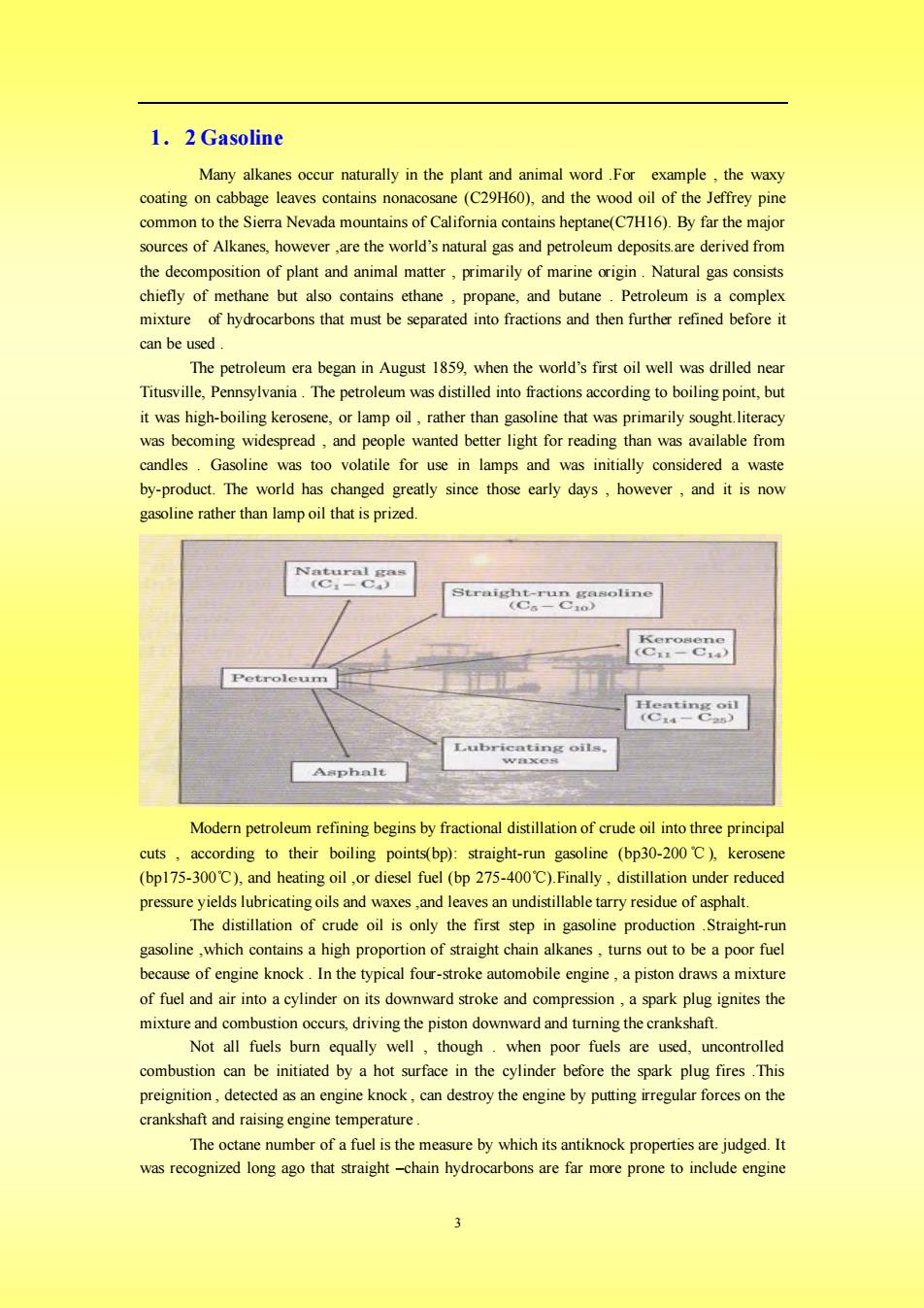
2Gasolinoccur naturally in the plant and animal word FoManyalkanexample,thewaxycoating on cabbage leaves contains nonacosane (C29H60),and the wood oil of the Jeffrey pinecommon to the Siera Nevada mountains of California contains heptane(C7H16).By far the majorsources of Alkanes, hoer,are the world's natural gas and petroleum depoederivedfrommatter,primarily of machiefly of methane but also contains ethane, propane, and butanePetroleumacomplemixtureof hydrocarbons that must be separated into fractions and then further refined before itcanbeuseoThe petroleum era began in August1859, when theworld's first oil well was drilled nealTitusville, Pennsylvaniahe petroeum was distiled intoactions accordingtoboilingpoin,buit was high-boiling kerosene, or lamp oil, rather than gasoline that was primarily sougwasbomingwidespreadandoplewantedbtterlightforreadingthanwasavailablomcandlesGasolinewas too volatile forusein lamps and wasinitially considered a wasteby-product. The world has changed greatly since those early days ,however,anditisnowgasoline rather than lamp oil that is prizedacuracsaPetroleunHontingAsphnltModern petroliningbeginsbyfractionaldisillationthree principacutsaccording to theirboiling points(bp):straight-run gasoline (bp30-200 C),kerosene(bp175-300C),and heating oil,or diesel fuel (bp 275-400C).Finally,distllation under reducedeldslubricatig oils and waxes,and leaves an undistillable tarry residue ressureasphafiorne oil is only the firstasolinehproportionofswhichahigroutpoorbecause of engine knock.In the typical four-stroke automobile engine,a piston draws a mixtureoffuel and airinto acylinder on its downward stroke and compressionaspark plug ignites themixture and combustion occugthepiston downward and turningthecrsdrivinglot allfuelsorfuels are used, uncontrolledburn equallywell,thoughrharface in the cylinder beforespark plugfirespreignition,detected as an engine knock,can destroy the engineby putting irregularforces on thcrankshaft and raising engine temperatureThe octane number of a fuel is the measure by which its antiknock properties are judged. Itwas recognized long ago that straight-chain hydrocarbons are far more prone to include engine
3 1.2 Gasoline Many alkanes occur naturally in the plant and animal word .For example , the waxy coating on cabbage leaves contains nonacosane (C29H60), and the wood oil of the Jeffrey pine common to the Sierra Nevada mountains of California contains heptane(C7H16). By far the major sources of Alkanes, however ,are the world’s natural gas and petroleum deposits.are derived from the decomposition of plant and animal matter , primarily of marine origin . Natural gas consists chiefly of methane but also contains ethane , propane, and butane . Petroleum is a complex mixture of hydrocarbons that must be separated into fractions and then further refined before it can be used . The petroleum era began in August 1859, when the world’s first oil well was drilled near Titusville, Pennsylvania . The petroleum was distilled into fractions according to boiling point, but it was high-boiling kerosene, or lamp oil , rather than gasoline that was primarily sought.literacy was becoming widespread , and people wanted better light for reading than was available from candles . Gasoline was too volatile for use in lamps and was initially considered a waste by-product. The world has changed greatly since those early days , however , and it is now gasoline rather than lamp oil that is prized. Modern petroleum refining begins by fractional distillation of crude oil into three principal cuts , according to their boiling points(bp): straight-run gasoline (bp30-200℃), kerosene (bp175-300℃), and heating oil ,or diesel fuel (bp 275-400℃).Finally , distillation under reduced pressure yields lubricating oils and waxes ,and leaves an undistillable tarry residue of asphalt. The distillation of crude oil is only the first step in gasoline production .Straight-run gasoline ,which contains a high proportion of straight chain alkanes , turns out to be a poor fuel because of engine knock . In the typical four-stroke automobile engine , a piston draws a mixture of fuel and air into a cylinder on its downward stroke and compression , a spark plug ignites the mixture and combustion occurs, driving the piston downward and turning the crankshaft. Not all fuels burn equally well , though . when poor fuels are used, uncontrolled combustion can be initiated by a hot surface in the cylinder before the spark plug fires .This preignition , detected as an engine knock , can destroy the engine by putting irregular forces on the crankshaft and raising engine temperature . The octane number of a fuel is the measure by which its antiknock properties are judged. It was recognized long ago that straight –chain hydrocarbons are far more prone to include engine
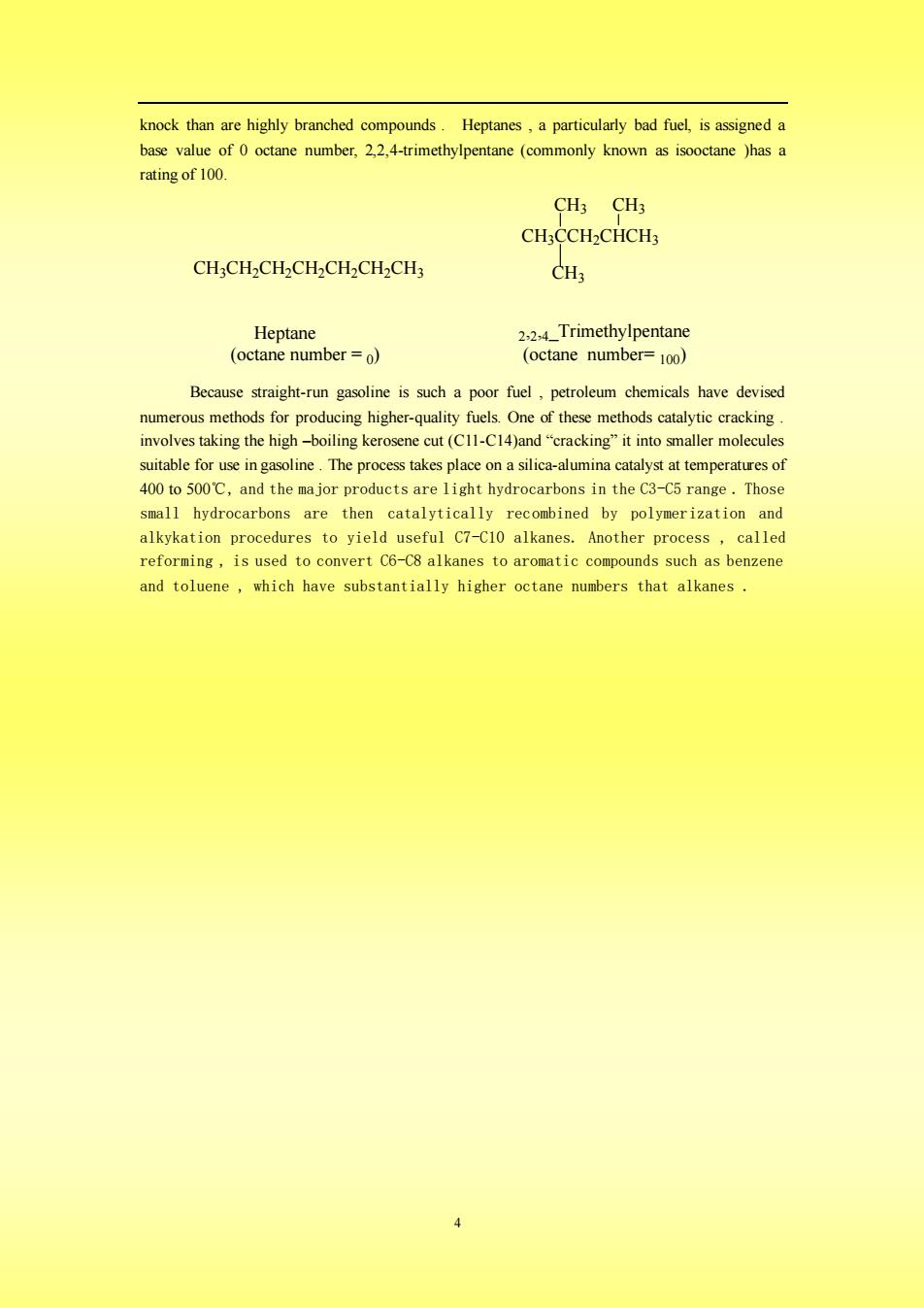
knokthanarehighybranchedmpoudHpanspariularybadaedbase value of 0 octane number,2,2,4-trimethylpentane (commonlyknown as isooctane)hasarating of 100.CH3CH3CH,CCHCHCH;CH;CH,CH,CH,CH2CH,CH3CH32.2.4_TrimethylpentaneHeptane(octane number = o)(octane number=100)Becausesgasoline is suchoorfuel,petroleumchemicals have devisedightnumerous methods for producing higher-quality fuels.One of these methods catalytic crackinginvolves taking the high -boiling kerosene cut (C11-C14)and "cracking" it into smaller moleculessuitable for use in gasoline, The process takes place on a silica-alumina catalyst at temperatures of400 to 500C, and the major products are light hydrocarbons in the C3-C5 range.Thosetalvticalne01is used to convert C6-C8 alkanes to aromatic compounds suchreforminbenzenand toluenewhich have substantially higher octane numbers that alkanes
4 knock than are highly branched compounds . Heptanes , a particularly bad fuel, is assigned a base value of 0 octane number, 2,2,4-trimethylpentane (commonly known as isooctane )has a rating of 100. CH3CH2CH2CH2CH2CH2CH3 Heptane (octane number = 0) CH3CCH2CHCH3 CH3 CH3 CH3 2,2,4_Trimethylpentane (octane number= 100 ) Because straight-run gasoline is such a poor fuel , petroleum chemicals have devised numerous methods for producing higher-quality fuels. One of these methods catalytic cracking . involves taking the high –boiling kerosene cut (C11-C14)and “cracking” it into smaller molecules suitable for use in gasoline . The process takes place on a silica-alumina catalyst at temperatures of 400 to 500℃, and the major products are light hydrocarbons in the C3-C5 range . Those small hydrocarbons are then catalytically recombined by polymerization and alkykation procedures to yield useful C7-C10 alkanes. Another process , called reforming , is used to convert C6-C8 alkanes to aromatic compounds such as benzene and toluene , which have substantially higher octane numbers that alkanes
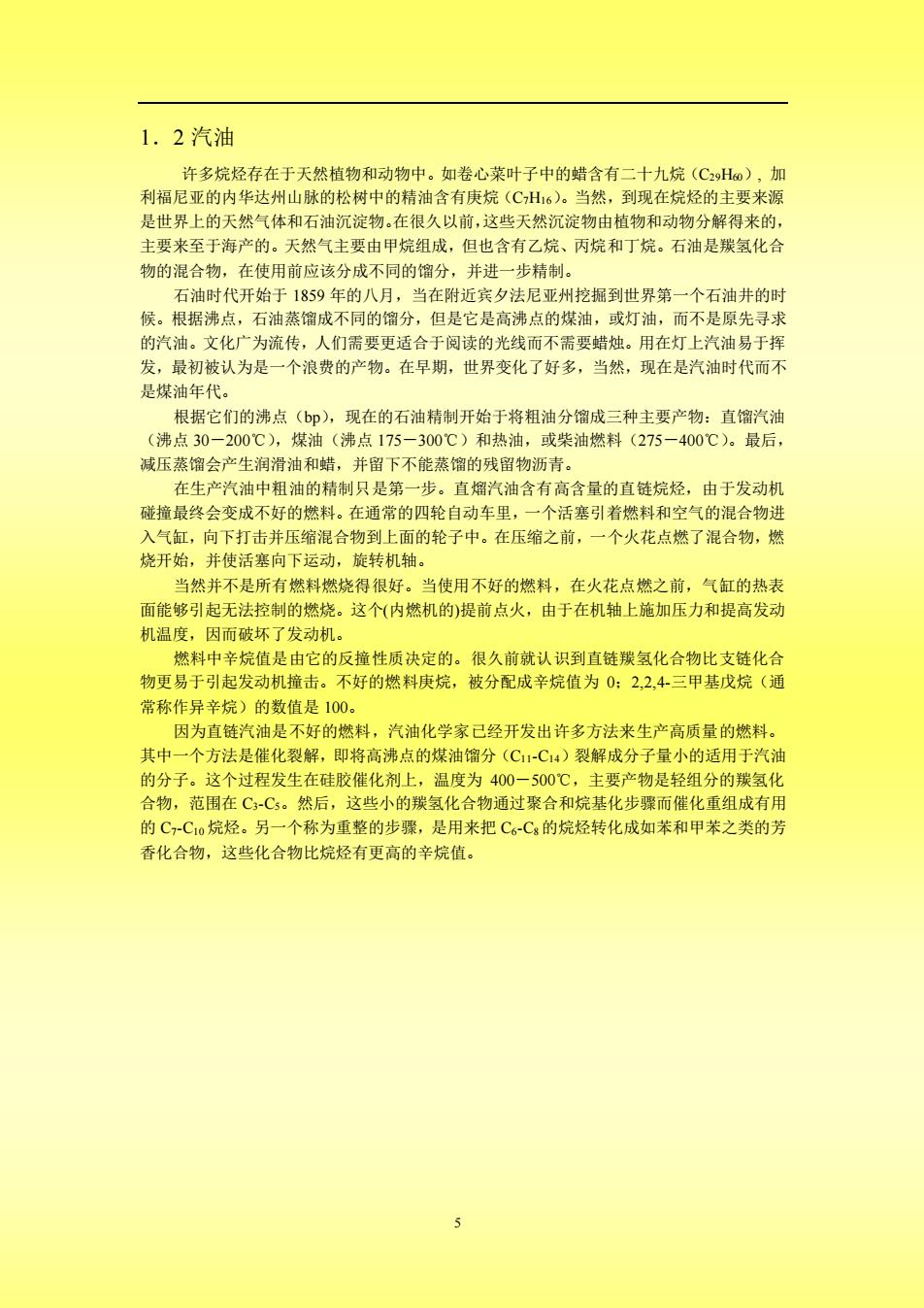
1.2汽油许多烷烃存在于天然植物和动物中。如卷心菜叶子中的蜡含有二十九烷(C2gHao),加利福尼亚的内华达州山脉的松树中的精油含有庚烷(C/H16)。当然,到现在烷烃的主要来源是世界上的天然气体和石油沉淀物。在很久以前,这些天然沉淀物由植物和动物分解得来的,主要来至于海产的。天然气主要由甲烷组成,但也含有乙烷、丙烷和丁烷。石油是羰氢化合在使用前应该分成不同的馏分,并进一步精制。物的混合物,石油时代开始于1859年的八月,当在附近宾夕法尼亚州挖掘到世界第一个石油井的时候。根据沸点,石油蒸馏成不同的馏分,但是它是高沸点的煤油,或灯油,而不是原先寻求的汽油。文化广为流传,人们需要更适合于阅读的光线而不需要蜡烛。用在灯上汽油易于挥发,最初被认为是一个浪费的产物。在早期,世界变化了好多,当然,现在是汽油时代而不是煤油年代根据它们的沸点(bp),现在的石油精制开始于将粗油分馏成三种主要产物:直馏汽油(沸点30-200℃),煤油(沸点175-300℃)和热油,或柴油燃料(275-400℃)。最后,减压蒸馏会产生润滑油和蜡,并留下不能蒸馏的残留物沥青。在生产汽油中粗油的精制只是第一步。直熠汽油含有高含量的直链烷烃,由于发动机碰撞最终会变成不好的燃料,在通常的四轮自动车里,一个活塞引着燃料和空气的混合物进入气缸,向下打击并压缩混合物到上面的轮子中。在压缩之前,一个火花点燃了混合物,燃烧开始,并使活塞向下运动,旋转机轴。当然并不是所有燃料燃烧得很好。当使用不好的燃料,在火花点燃之前,气缸的热表面能够引起无法控制的燃烧。这个(内燃机的)提前点火,由于在机轴上施加压力和提高发动机温度,因而破坏了发动机。由它的反撞性质决定的。很久前就认识到直链羰氢化合物比支链化合科中文心#情物更易于引起发动机撞击。不好的燃料庚烷,被分配成辛烷值为0224-三甲基戊烷(通常称作异辛烷)的数值是100因为直链汽油是不好的燃料,汽油化学家已经开发出许多方法来生产高质量的燃料。其中一个方法是催化裂解,即将高沸点的煤油馏分(Cil-Ci4)裂解成分子量小的适用于汽油的分子。这个过程发生在硅胶催化剂上,温度为400一500℃,主要产物是轻组分的羰氢化合物,范围在C-Cs。然后,这些小的羰氢化合物通过聚合和烷基化步骤而催化重组成有用的C-Cio烷烃。另一个称为重整的步骤,是用来把C-Ca的烷烃转化成如苯和甲苯之类的芳香化合物,这些化合物比烷烃有更高的辛烷值
5 1.2 汽油 许多烷烃存在于天然植物和动物中。如卷心菜叶子中的蜡含有二十九烷(C29H60), 加 利福尼亚的内华达州山脉的松树中的精油含有庚烷(C7H16)。当然,到现在烷烃的主要来源 是世界上的天然气体和石油沉淀物。在很久以前,这些天然沉淀物由植物和动物分解得来的, 主要来至于海产的。天然气主要由甲烷组成,但也含有乙烷、丙烷和丁烷。石油是羰氢化合 物的混合物,在使用前应该分成不同的馏分,并进一步精制。 石油时代开始于 1859 年的八月,当在附近宾夕法尼亚州挖掘到世界第一个石油井的时 候。根据沸点,石油蒸馏成不同的馏分,但是它是高沸点的煤油,或灯油,而不是原先寻求 的汽油。文化广为流传,人们需要更适合于阅读的光线而不需要蜡烛。用在灯上汽油易于挥 发,最初被认为是一个浪费的产物。在早期,世界变化了好多,当然,现在是汽油时代而不 是煤油年代。 根据它们的沸点(bp),现在的石油精制开始于将粗油分馏成三种主要产物:直馏汽油 (沸点 30-200℃),煤油(沸点 175-300℃)和热油,或柴油燃料(275-400℃)。最后, 减压蒸馏会产生润滑油和蜡,并留下不能蒸馏的残留物沥青。 在生产汽油中粗油的精制只是第一步。直熘汽油含有高含量的直链烷烃,由于发动机 碰撞最终会变成不好的燃料。在通常的四轮自动车里,一个活塞引着燃料和空气的混合物进 入气缸,向下打击并压缩混合物到上面的轮子中。在压缩之前,一个火花点燃了混合物,燃 烧开始,并使活塞向下运动,旋转机轴。 当然并不是所有燃料燃烧得很好。当使用不好的燃料,在火花点燃之前,气缸的热表 面能够引起无法控制的燃烧。这个(内燃机的)提前点火,由于在机轴上施加压力和提高发动 机温度,因而破坏了发动机。 燃料中辛烷值是由它的反撞性质决定的。很久前就认识到直链羰氢化合物比支链化合 物更易于引起发动机撞击。不好的燃料庚烷,被分配成辛烷值为 0;2,2,4-三甲基戊烷(通 常称作异辛烷)的数值是 100。 因为直链汽油是不好的燃料,汽油化学家已经开发出许多方法来生产高质量的燃料。 其中一个方法是催化裂解,即将高沸点的煤油馏分(C11-C14)裂解成分子量小的适用于汽油 的分子。这个过程发生在硅胶催化剂上,温度为 400-500℃,主要产物是轻组分的羰氢化 合物,范围在 C3-C5。然后,这些小的羰氢化合物通过聚合和烷基化步骤而催化重组成有用 的 C7-C10 烷烃。另一个称为重整的步骤,是用来把 C6-C8 的烷烃转化成如苯和甲苯之类的芳 香化合物,这些化合物比烷烃有更高的辛烷值